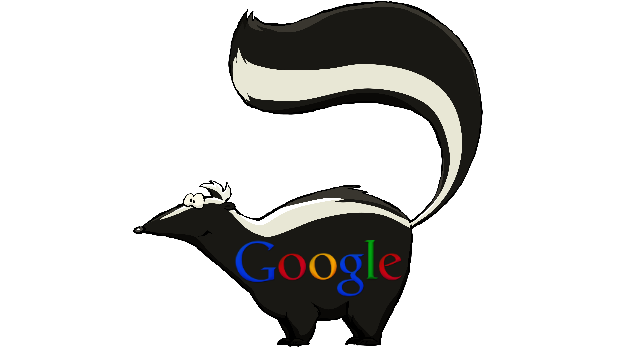
The Next Black & White Animal for New Google Update: Google Skunk
If you’ve worked on the Internet in the past 12+ years, you may have felt the sting of a Google update to their search algorithm. Nowadays, just hearing the words “Panda” or “Penguin” will send a company-wide shiver up everyone’s spines. For some reason, Google likes to name these updates after black and white animals and as with most things “SEO,” there’s a certain amount of speculation and theorizing involved. Just like the inevitable next version of Apple’s iPhone, there will surely be another Google update to their algorithm. This algorithm update that Google has brewing will leave website owners, SEO specialists, bloggers and other Internet people pulling their hair out.
Are you ready to hear what we believe is the next black and white, anti-web spam, animal algorithm update that Matt Cutts is raising over at Google?
While we wouldn’t bet the farm on the skunk part, here are some things you can be sure the Google update will focus on:
Weak content gets smashed. Again.
This shouldn’t be a surprise after Google’s past duplicate content penalties, but you would be amazed at how many people still publish tons of low quality, duplicate content. If you use guest bloggers to pump content into your blog, be very, very careful. Thin, spun, and weak content is right in the middle of Google’s cross hairs. Low quality guest bloggers will sometimes give the same exact article to several different websites. Google may see this as an attempt to game the system and slap a penalty on your site. Some guest bloggers do great work, but keep your eyes peeled for duplicate or copied content. Fortunately, you don’t need to scour the Internet for hours looking to see if your content is posted elsewhere.
Instead, consult these tools for checking duplicate content. Even better than using guest bloggers, create your own, original content. You’re an expert in your field, so write good, quality content and post it on your blog or website. That’s a strong start to creating a solid content marketing strategy.
Poor backlink profile
If your site’s been around for a while, which in Internet terms is more than 5 years, you might unknowingly have a poor backlink profile. A backlink, if you don’t already know, is a link from a website that points to your site. Poor means spammy and low quality, which Google has very publicly declared it will penalize.
Unfortunately, a poor backlink profile isn’t always your fault, and, worse, you may not even know you have one. Back in the “Wild, Wild West” days of SEO, lots of companies, big and small alike, did some less than stellar practices, also known as blackhat, that are specifically intended to beat the algorithm and gain top keyword rankings.
If you’ve ever hired an SEO firm or consultant in the past, no matter how honest they said they were, you still should check your backlink profile. SEOmoz’s Open Site Explorer is a great tool to use for this. If you do a random spot check on a few of your links and they lead to sites you wouldn’t dare forward to your Grandma, then odds are you don’t want them linking back to your site. Wish you could just get rid of them? You’re in luck because Google has been kind enough to provide a tool to get rid of spam and low quality links. Behold the Google Disavow tool. This tool, in short, tells Google you don’t want them to look at the links for one reason or another. Now before you go hog wild on with this powerful tool, do some research and be sure you’re disavowing only bad links that you really want gone, and not links that you want to keep. Don’t forget that backlinks are still important and provide significant SEO value.
Rumors are just that… until Google makes it official
The SEO industry is known for their high amount of speculation, regarding updates. That is the nature of the SEO beast, as Google doesn’t release a ton of details regarding their updates. Usually the vagueness of a Google update sends everyone scrambling to check their site’s backlinks with a fine-toothed comb. But here’s an easy way to do it: Take each blog post, article ,and commentary, including this one, with a giant grain of salt. You should take note of the issue, do some investigation and analysis, and then act slowly and surely. Just as there is no quick way to a #1 keyword ranking, there is no quick fix to crawl out from under a Google update penalty. There are horror stories of sites deleting almost every piece of content and backlink just days after Google’s latest black and white beast was let out of its cage. Does all this gloom and doom have you worried? Don’t freak, because we’ve got your back.
So what CAN you do to protect your site from the next Google update?
The constant threat of a Google update has most webmasters and SEO specialists shaking in their boots. Google always preaches about wanting to help the user get a better search result and experience. Almost every link building technique you’ve heard of in the past 5 years is almost certain to line you up for a Google penalty. SEOMoz’s Rand Fishkin, a leader in the SEO industry, posted about the death of traditional link building, and the rebirth of “link earning.” There’s no quick way to obtaining a 1st page ranking. Good rankings, like most good things, require lots of hard work. One thing that always rings true in Google’s ears: high-quality and original content.
Here are the 2 must-knows for SEO that’ll keep you in the clear of a Google update penalty, and climbing up the keyword rankings:
1. Keep your content natural and not over-stuffed with keywords
2. Keep your keywords and landing pages diverse.
So maybe you won’t be reading about the Google Skunk update, but you can be sure sometime in the future – and sooner rather than later – there will be another anti-spam Google update. If you keep up the high-quality content, diverse link profile, you can avoid getting skunked by the next big Google update.
Do you have any ideas on what the next Google animal will be? Or do you think the next update will ding some other factor? We would love to hear about it in the comments!
© 2013 – 2018, Contributing Author. All rights reserved.




